
Pool of Radiance is a role-playing video game developed and published by Strategic Simulations, Inc (SSI) in 1988. It was the first adaptation of TSR's Advanced Dungeons & Dragons (AD&D) fantasy role-playing game for home computers, becoming the first episode in a four-part series of D&D computer adventure games. The other games in the "Gold Box" series used the game engine pioneered in Pool of Radiance, as did later D&D titles such as the Neverwinter Nights online game. Pool of Radiance takes place in the Forgotten Realms fantasy setting, with the action centered in and around the port city of Phlan.
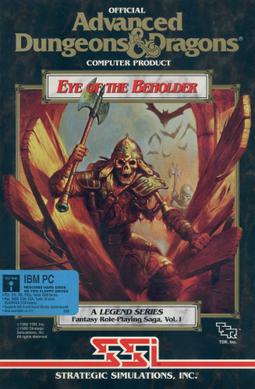
Eye of the Beholder is a role-playing video game for personal computers and video game consoles developed by Westwood Associates. It was published by Strategic Simulations, Inc. in 1991, for the MS-DOS operating system and later ported to the Amiga, the Sega CD and the SNES. The Sega CD version features a soundtrack composed by Yuzo Koshiro and Motohiro Kawashima. A port to the Atari Lynx handheld was developed by NuFX in 1993, but was not released. In 2002, an adaptation of the same name was developed by Pronto Games for the Game Boy Advance.

Curse of the Azure Bonds is a role-playing video game developed and published by Strategic Simulations, Inc (SSI) in 1989. It is the second in a four-part series of Forgotten Realms Advanced Dungeons & Dragons Gold Box adventure computer games, continuing the events after the first part, Pool of Radiance.

Gold Box is a series of role-playing video games produced by SSI from 1988 to 1992. The company acquired a license to produce games based on the Advanced Dungeons & Dragons role-playing game from TSR, Inc. These games shared a common game engine that came to be known as the "Gold Box Engine" after the gold-colored boxes in which most games of the series were sold.

Pools of Darkness is a role-playing video game published by Strategic Simulations in 1991. The cover art and introduction screen shows a female drow. It is the fourth entry in the Pool of Radiance series of Gold Box games, and the story is a continuation of the events after Secret of the Silver Blades. The novel loosely based on the game was released in 1992. Like the previous games in the series, it is set in the Forgotten Realms, a campaign setting from Dungeons & Dragons. Players must stop an invasion from an evil god, eventually traveling to other dimensions to confront his lieutenants.
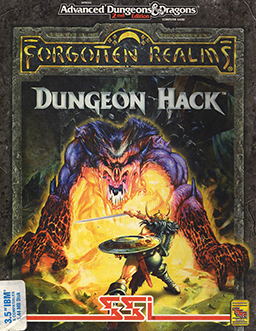
Dungeon Hack is a 1993 role-playing video game developed by DreamForge Intertainment and published by Strategic Simulations for DOS and NEC PC-9801.

Dragon Wars is a fantasy role-playing video game developed by Rebecca Heineman and published by Interplay Productions in 1989 and distributed by Activision.

Secret of the Silver Blades is the third in a four-part series of Forgotten Realms Dungeons & Dragons "Gold Box" adventure role-playing video games. The game was released in 1990.

Buck Rogers: Countdown to Doomsday is a role-playing video game set in the Buck Rogers XXVC universe. It was published in 1990 by Strategic Simulations for MS-DOS, Commodore 64, and Amiga. A Sega Genesis version was released in 1991. Matrix Cubed is the 1992 sequel.

Buck Rogers: Matrix Cubed is a role-playing video game for MS-DOS developed and published by Strategic Simulations 1992. It uses the Gold Box engine. The game takes place in the Buck Rogers XXVC campaign setting. Matrix Cubed is a sequel to Countdown to Doomsday which came out in 1990.

J.R.R. Tolkien's The Lord of the Rings, Vol. I is a role-playing video game published by Interplay Productions. It is an adaptation of The Fellowship of the Ring by J. R. R. Tolkien, being the first volume in The Lord of the Rings. The game was released in 1990 for DOS, in 1991 for the Amiga and PC-98, and in 1992 for the FM Towns. It was followed by J.R.R. Tolkien's The Lord of the Rings, Vol. II: The Two Towers. It was originally designed for the Commodore 64, but the production team switched to the newer platforms. The game was designed by Troy A. Miles, Scott Bennie, Jennell Jaquays, and Bruce Schlickbernd.
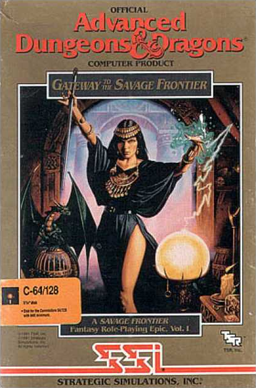
Gateway to the Savage Frontier (1991) is a Gold BoxDungeons & Dragons computer game developed by Beyond Software and published by SSI for the Commodore 64, PC and Amiga personal computers.

Death Knights of Krynn is the second in a three-part series of Dragonlance Advanced Dungeons & Dragons "Gold Box" role-playing video games, published by Strategic Simulations. The game was released in 1991.

The Dark Queen of Krynn is the third in a three-part series of Dragonlance Advanced Dungeons & Dragons "Gold Box" role-playing video games. The game was released in 1992.

Eye of the Beholder II: The Legend of Darkmoon is a 1991 role-playing video game and the sequel to the first Eye of the Beholder. It used a modified version of the first game's engine, added outdoor areas and greatly increased the amount of interaction the player had with their environment, along with substantially more role-playing aspects to the game. A sequel, Eye of the Beholder III: Assault on Myth Drannor, was released in 1993.

Eye of the Beholder III: Assault on Myth Drannor is a 1993 role-playing video game and the sequel to Eye of the Beholder and Eye of the Beholder II: The Legend of Darkmoon.
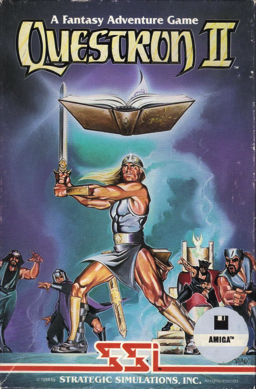
Questron II a 1988 role-playing video game published by Strategic Simulations for the Apple II, Apple IIGS, Atari ST, Commodore 64, IBM PC, and Amiga. It is the sequel to 1984's Questron. The story and original design is credited to Quest Software, the programming and artwork is credited to Westwood Associates.

Menzoberranzan is a 1994 role-playing video game created by Strategic Simulations (SSI) and DreamForge Intertainment. Menzoberranzan uses the same game engine as SSI's previous game, Ravenloft: Strahd's Possession (1994), and is set in the Advanced Dungeons & Dragons Forgotten Realms campaign setting.
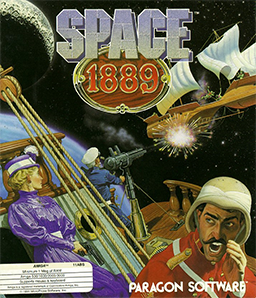
Space: 1889 is an adventure game developed by Paragon Software and published in 1990 for Amiga, Atari ST, and MS-DOS.
Pool of Radiance is a series of role-playing video games set in the Forgotten Realms campaign settings of Dungeons & Dragons; it was the first Dungeons & Dragons video game series to be based on the Advanced Dungeons & Dragons rules.




















